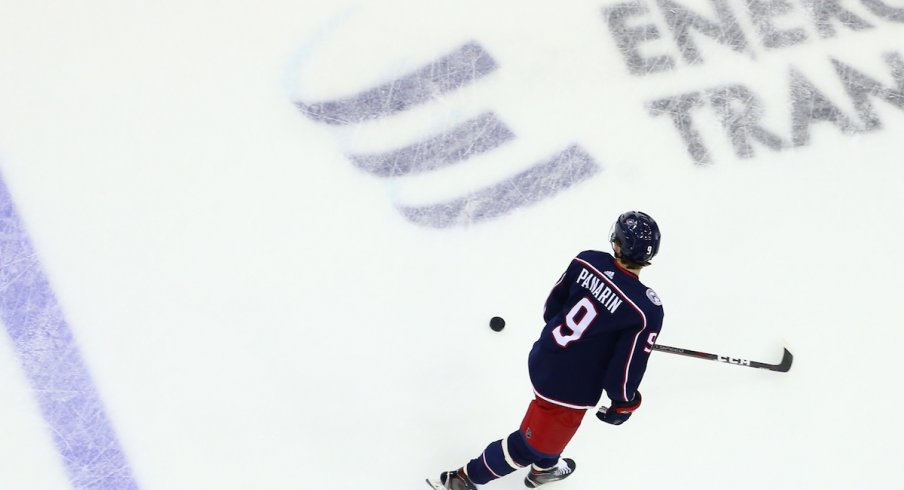Editor's Note: We're pleased to feature this piece from Matt Souva, a hockey fan and analyst who writes at Buckeye State Hockey.
By now, I trust you’ve heard: the Columbus Blue Jackets are suddenly between a rock and a hard place. Tuesday afternoon, Sportsnet’s Elliotte Friedman dropped some unexpected news about Artemi Panarin: the star winger isn’t interested in a new contract with Columbus right now, and the Blue Jackets are listening to trade offers.
Chris Pennington broke down the news and the team’s reaction here at 1OB.
The details remain confusing, and the logic underlying the player’s contract choice is not obvious.
To say this is a problem for the Blue Jackets is an understatement. Consider, for comparison, the New York Islanders and captain/center/face of the franchise John Tavares. Over the past season, Tavares has (justifiably) been a major focus for national hockey media. The high-scoring center is an upcoming unrestricted free agent, and is one of the best offensive talents in the NHL.
Without a new contract in place, part of the league-wide focus at the 2017-18 trade deadline was on the Islanders’ choice to keep Tavares. Post-deadline, that decision becomes a point of anxiety. What if Tavares leaves New York, and the Islanders get no return? Was then-GM Garth Snow in the wrong for crippling the future of the franchise out of a misguided hope that Tavares would remain?
An alternate reality brings different questions that still strike with the same poignancy. Imagine that the Alternate Islanders had moved Tavares. Was the return even close to enough? What are the chances of any given prospect or draft pick becoming a top-ten NHL scorer like Tavares (via H-R)? Did the team blow their chance at keeping Tavares by acquiescing too soon?
Except in the scenario where John Tavares remains with the Islanders, criticism was always going to follow the team. Here in the actual timeline, that uncertainty in New York has yet to be resolved (as of this writing), and leaves the Islanders in limbo.
Consider, then, that Artemi Panarin may be a better hockey player than John Tavares.
If you want to know how big of a deal it is that Panarin might be available... pic.twitter.com/ZO2kXWj1Ly
— Sean Tierney (@ChartingHockey) June 19, 2018
So what do the Blue Jackets do?
The only criteria that matters: they cannot let Artemi Panarin go unless they get a player equivalent to Artemi Panarin.
Consider what that means: Panarin was a brilliant wizard on a team with otherwise limited offensive talents. Panarin was one of only 21 NHL players to hit 80+ points this year (via the skater list at H-R), and an utterly astounding shot generating machine for the Blue Jackets (via Natural Stat Trick). He managed to be an all-world scoring force, and a truly complete player. Panarin’s standing is further magnified by stature in franchise history, having put together the greatest season by any skater in a Blue Jackets sweater (yes, even better than Rick Nash).
And Panarin’s impact is made more impressive when considering his peers. As Bill Comeau rightly notes, those peers are Sidney Crosby and Connor McDavid.
PANARIN TRYING TO CUT IN... SCORES!!! GAME WINNER IN OVERTIME!!! WHAT A GOAL!!! #CBJ pic.twitter.com/XCYTw75Dhe
— 1st Ohio Battery (@1stOhioBattery) April 13, 2018
All of this is to say: the Columbus Blue Jackets simply cannot accept a trade that involves a bundle of lesser prospects, or late draft picks, or middle-tier NHLers. They stand to lose a superstar, and must either keep him, or find a way to adequately replace him.
Prospects and draft picks are a risk. What are the chances that any given kid will become an elite-level NHLer? Not very high, and particularly low for draft picks. This means prospect or young player targets need to be obviously high quality: bring on William Nylander, Kyle Connor, or Sebastian Aho. But also understand, that’s a hard sell for the Leafs, Jets, and Hurricanes, as those players are both good and cost-controlled. Those players will be hard to get.
Already-established NHLers are not a risk in the same way, but represent a different chance to screw up: players in their mid-20s have already hit their peaks (via Hockey-Graphs), so without a Panarin-equivalent in return, filling up roster spots with “good-not-great” is a clear step backward. Being an NHL regular is different from being a game-breaking star.
Starting today, the Columbus Blue Jackets are stuck in the same way the New York Islanders have been stuck, albeit with a shot at the playoffs. The best path for the Jackets is for Panarin to remain in Columbus, but that isn’t a choice the franchise can make for the player. Luckily for team and fans, there’s still time for the player to change his tune, but the apparent urgency of the news brings risk.
How the Blue Jackets choose to proceed represents a difficult decision point, and will irreversibly change the franchise for years to come.
Matt Souva is on Twitter @zekebud.
Follow 1st Ohio BatteryFacebook, Twitter, Instagram and YouTube
